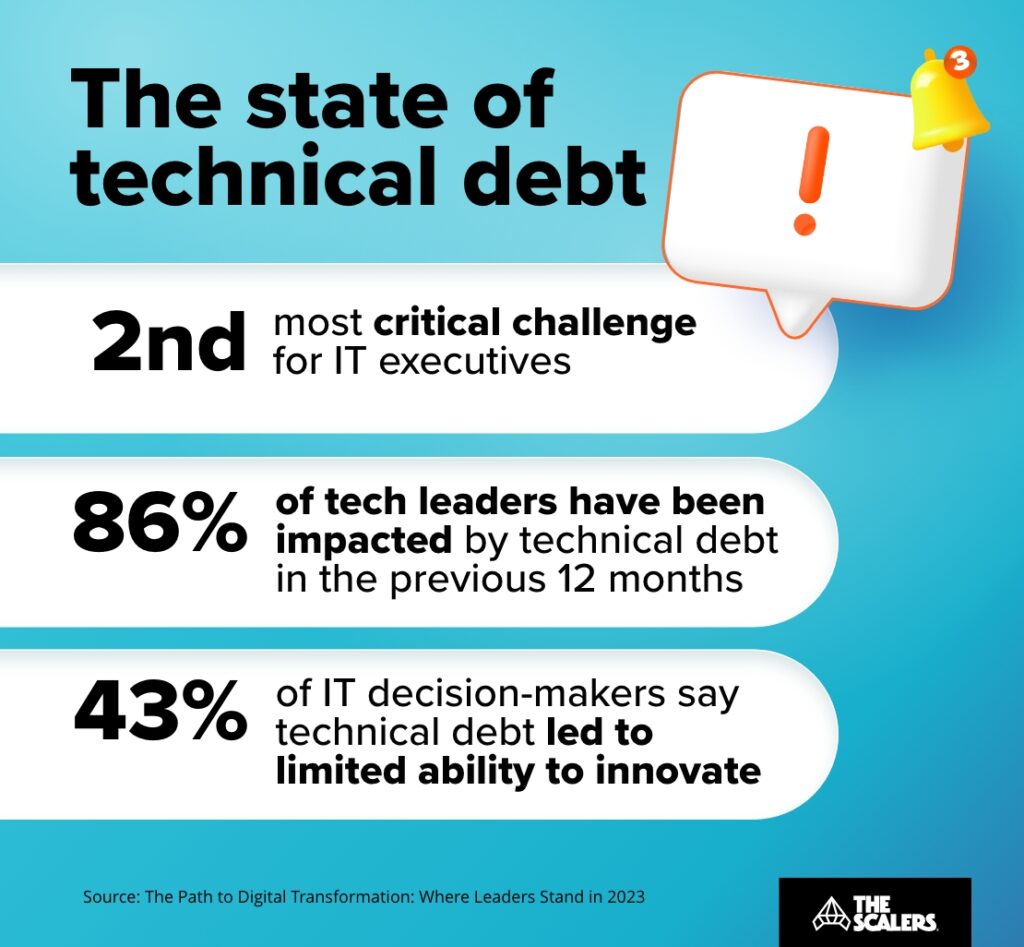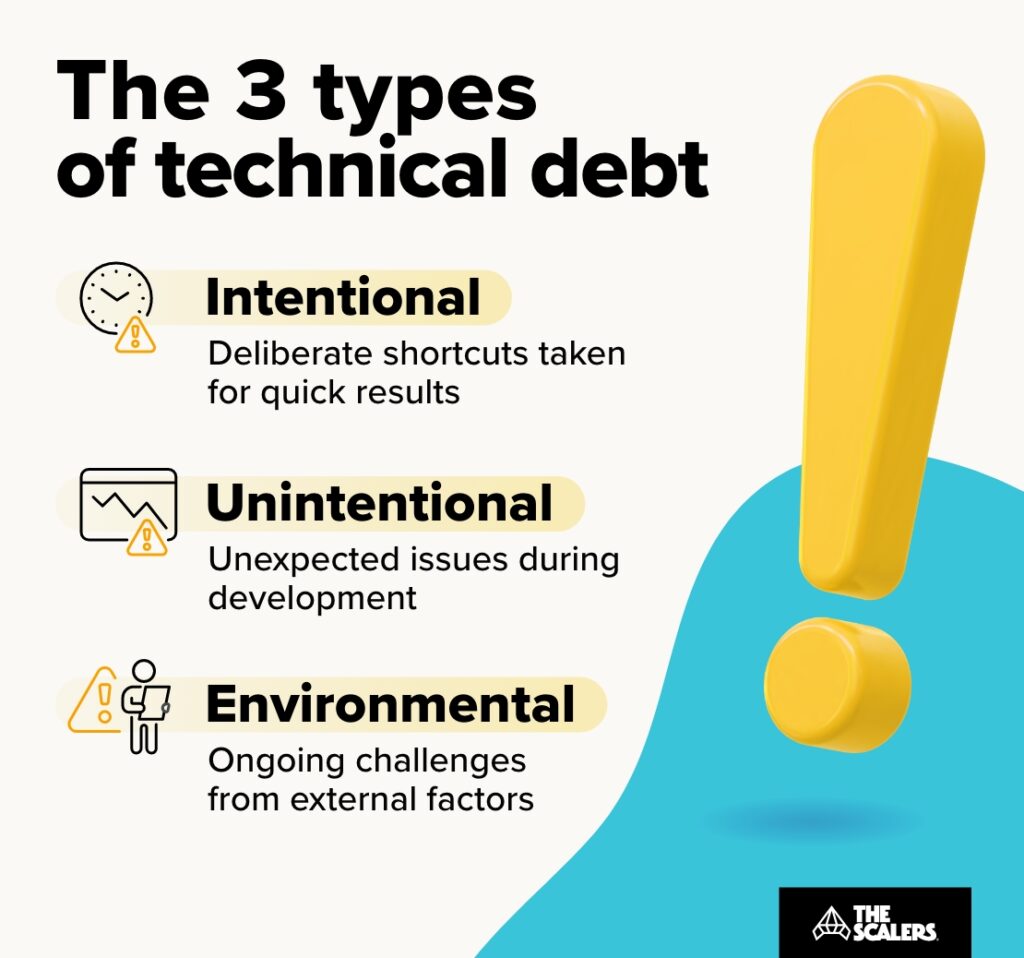Finding effective ways to tackle technical debt is one of the most critical challenges CTOs face in their career.
Especially when such debt is inherited from organisations’ past bad practices.
In this article, we’ll share the best solutions to manage technical debt — based on our experience extending software development teams for tech leaders in multiple industries.
Before diving into the strategy, we’ll start by defining the topic with a practical example and explaining the three types of technical debt.
Let’s make a start!
What is technical debt?
Technical debt (also known as tech debt) refers to the costs an organisation must cover due to prioritising fast and less effective solutions over optimal ones.
The debt is in the form of time, money, and/or resources.
For example, a startup can incur technical debt when planning to release its Minimum Viable Product (MVP). Tight deadlines and pressure from investors may force executives to outsource low-quality developers to launch their product as soon as possible.
The result? Prolonged development cycles, scalability challenges, and security vulnerabilities.
The consequences of accumulating technical debt for this startup went beyond just launch delays and spending more money. It affected the company’s long-term success.

The 3 types of technical debt
Despite the diverse range of technical debt types, they can be grouped into three categories: intentional, unintentional, and environmental.

Intentional debt
Intentional debt occurs when a company chooses a faster development framework or solution to build software — fully aware of its risks and issues — instead of the best.
Let’s go back to the example we shared earlier in this article, where we talked about a startup launching its MVP. If this business intentionally hired a team of inexperienced developers to release its product quickly, it incurred intentional debt.
And that’s not necessarily bad.
In some cases, organisations manage to launch a decent product and start generating revenue sooner. This early revenue can help them address and solve debugging problems that may arise in the future.
Still, it’s a risky move, as it may lead to future delays in implementing new features and addressing performance issues as the user base grows.
Unintentional debt
Unintentional debt occurs when development teams implement bad practices without knowing it.
Companies affected by unintentional debt generally hire low-quality developers or neglect proper testing and code review processes. In both cases, this poses a serious threat, as companies can be unaware of technical issues, including security vulnerabilities, for a long time.
Environmental debt
Environmental debt occurs when technical debt has accumulated over time due to the inaction of development teams in managing and maintaining programs.
Let’s consider a web application built on an older programming language and framework version. As the language and framework evolve, the application’s initial functional code becomes incompatible with the latest versions, causing features to break or performance to drop.
To address this challenge, it’s common to briefly pause or delay development after spotting feature problems. Engineers adjust the code and ensure it works well with the latest versions to provide a smoother, more compatible performance.
Technical debt will accrue if developers don’t stay updated and keep up with these changes.
Best solutions to tackle technical debt as a CTO
Now that we’ve discussed what technical debt (really) is and its types, we’ll list effective solutions you can use to handle it.
Refactoring
Refactoring involves the restructuration of code for better readability, maintainability, and performance without changing its external behaviour.
In other words, correcting poor or bad code.
Despite reservations from some who see it as time-consuming or unnecessary, this approach extends beyond mere bug fixing and tackles technical debt by enhancing overall code quality.
Establishing a proper QA process
Setting up a rigorous quality assurance (QA) process contributes to improving code quality.
With a structured QA process, you can detect potential issues before they escalate, making the refactoring process smoother. The synergy between refactoring and QA fosters an effective development environment.
Tracking technical debt
Treat technical debt tasks as any other development project in your team’s backlog. Keeping it in the mix with your regular work ensures it’s on your radar, preventing it from slipping through the cracks.
Think of tracking technical debt like organising your daily to-do list or weekly sprints. If you treat it the same way you handle other assingments, it won’t get overlooked, and you’ll always have a developer ready to make the necessary fixes.
Setting coding best practices
To mitigate technical debt, developers must follow common code etiquette and standards. These practices are often informal (and personal), so what can you do as a CTO to ensure everyone in your tech team is on the same page?
Consider establishing an internal set of guidelines and keep them in a place where developers can easily access them. Then, train developers on the coding best practices you’ve built.
After that, you can set an action plan to reduce technical debt. This process involves allocating specific times for team code clean-up efforts, favouring a step-by-step approach rather than tackling the entire debt at once.
Performing code reviews
Code reviews provide a fresh look, catching typos and bugs that might be missed in software development. It helps prevent the buildup of technical debt by addressing issues early on.
Performing these reviews ensures a thorough testing process, reducing the chances of long-term recurring problems and avoiding hidden issues in the final product.

Partnering with an offshore company
Collaborating with an offshore development company is a smart way to reduce technical debt.
Why? Onboarding overseas talent not only brings new ideas and skills to your team but also enhances your business capacity to resolve issues faster and more efficiently.
Adopting a high-value offshoring approach means you can assemble a larger development and QA team stocked with top-class engineers. And unlike their Western counterparts, they will stay for the long term, preventing knowledge loss.
In the following section, we’ll discuss how working with The Scalers — one of the best offshore development companies — can help you handle debt.
How can The Scalers help you prevent technical debt?
At The Scalers, we build world-class, dedicated and 100% culturally aligned software development teams in Bangalore, India.
And we have a proven track record assisting organisations in preventing technical debt.
For instance, we helped Ykone and Taxback Group address debt and transition from legacy systems to newly developed ones.
Here’s how we did it:
- We built offshore teams, employing our renowned seven-step recruitment process, to hire elite developers and cover Ykone’s and Taxback Group’s unique needs.
- The recruitment process sources the top 1% of Indian talent. Ykone and Taxback Group business leaders got to choose elite developers to solve their challenges (including technical debt).
- Our team provided operational support, including setup assistance and legalities, and furnished office spaces for their new team members.
- The offshore teams were designed for scalability, allowing Ykone and Taxback Group to grow their initial team sizes (and with visions of extending them in the future).
- Offshore developers were pivotal in reducing technical debt and developing and delivering flagship products, such as Campaygn for Ykone and a customised CRM system for Taxback Group.
Thanks to our partnership, both companies transitioned from facing technical debt challenges to achieving market leadership in their respective industries.
We were struggling to find talented developers in Paris, but we found them in Bangalore with The Scalers. Our partnership is now in its sixth year, and it’s amazing to see how far they have pushed our business forward.

In summary
Technical debt is a headache for CTOs and other tech leaders. But only if they don’t know how to tackle it.
Packed with the insights shared in this guide, you should be able to manage debt and save time finding a way to fix recurring issues that may affect your business for years to come.
Key takeaways:
-
1
Technical debt results from prioritising quick, suboptimal solutions, incurring time, money, or resource costs.
-
2
Debt can be intentional (aware of risks), unintentional (unknowingly bad practices), or environmental (accumulates over time).
-
3
CTOs can handle technical debt through refactoring, coding best practices, code reviews, and partnering with offshore companies.
-
4
Partnering with offshore companies, like The Scalers, brings top talent, operational support, and scalability, preventing technical debt.
-
5
The Scalers helped Ykone and Taxback Group overcome technical debt, transition to new systems, and achieve market leadership.
If you need help reducing debt and want to extend your dev team with top talent, contact us, and one of our senior executives will contact you shortly. You’ll get a tailored proposal matched to your needs.
Build Your Team,
Not Just a Contract
With The Scalers’ offshore dedicated development team, you get engineers who join your workflow for the long run. Grow steadily, stay flexible, and work with people who care about the product as much as you do.








